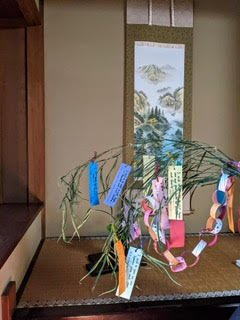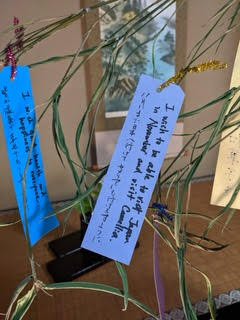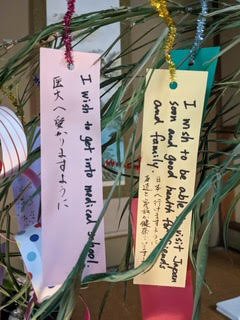
This year's Tanabata could not have been more special. We visited the Camellia Garden Teahouse in north west Kyoto, live on Instagram, for a special tea ceremony. Atsuko san, Nao san, and Kieren san welcomed us into the beautiful 100 year-old teahouse, and shared a bowl of tea, and a Tanabata sweet with us.
In this article, we're going to share the highlights of the morning, before sharing the fascinating interview that we had with Camellia Director Atsuko san in the days leading up to our event.

Visiting Camellia
Firstly though, let me explain how we first met the lovely proprietor of Camellia in Kyoto.
I first visited Camellia in my earliest days in Kyoto over ten years ago. In those days, Camellia was in Ninenzaka near Kiyomizu, upstairs in an old geisha house, and I remember walking up old wooden stairs to reach the small tatami room.
Kyoto had already entranced me, but I believe that it was this first experience of tea ceremony with kind Atsuko san, that opened my eyes to the astonishingly beautiful world of Kyoto arts.
The yuzu sweets that were served with the tea were so delicious I brought home a small box!
Since those days, Camellia have moved to two new premises, Camellia Flower and Camellia Garden.
Camellia Flower is tucked just behind Ninenzaka in a small street. I visited one autumn when I was in the city on my own. Camellia is a lovely place to go to experience the beauty of tea ceremony, to learn about tea and to ask one or two questions. Tea ceremony with Camellia is both an authentic experience and accessible for English speakers.
Camellia Garden is located in the north west of Kyoto near to the entrance of Ryoanji. The house is over 100 years old, and is surrounded by traditional gardens. It is here that we were able to meet with Atsuko san by way of the magic of Instagram Live.

[Photo: Camellia]
Instagram Live from Camellia Garden
On this special morning of the Japanese Star Festival of Tanabata, Kyoto was also celebrating the month-long festival of Gion Matsuri - which is one of the three largest festivals in Japan and dates back to the Heian era in Japan when Kyoto originally became the capital.
For tea ceremony, the host carefully selects items for the appreciation of the guests, and Atsuko san introduced us to the tokonoma alcove, which she had thoughtfully themed for Gion Matsuri.
We were introduced to the scroll which displayed the four gods which are prayed to for the peace and protection of Kyoto.
A detailed miniature brightly-coloured Gion Matsuri float was beautifully displayed on a small tray. We learned that many floats travel around Kyoto, and there are special food and souvenir stalls to enjoy. Chimaki (good luck charms) are put in front of homes for protection.
The ikebana flowers were hiougi, which evoke the shape of the hinoki cypress fan which ladies of the Heian court used all those years ago. Hiougi, or leopard flower, is the flower for Gion Matsuri.
Near to the edge of the tokonoma was a beautiful flowing branch of bamboo, with colourful tanzaku paper strips for our Tanabata wishes.

[Photo: Camellia]
Tea Ceremony
The tea ceremony implements were before the tokonoma on the tatami, with the sunlit garden as a beautiful background. Shadows from the garden cast along the tatami floor.
Atsuko san wore a beautiful inky kimono, which was the mesmerising colour of a summer night sky, and it had a motif on it in delicate gold of a peacock's tail fan. The pattern on the feather design looked like gold stars, and so the kimono combined with the beautiful inky swirl of the chawan teabowl to evoke the night sky where, according to the Japanese legend of Tanabata, the separated lovers can meet as stars.
The chawan was beautiful Kyo-yaki ware, made by highly skilled Kyoto artisans in a ceramic art tradition that dates back to the Edo era.
The chasen tea whisk, and the chashaku matcha spoon, the hishaku water ladle and ladle rest, and the receptacle for the used water were all made from bamboo.
The natsume tea caddy contained bright green matcha powder from Uji.
Atsuko san explained to us that the utensils are chosen so that we can feel the season, and so that we may enjoy on this day this moment together. It's a zen philosophy, ichigo ichie: this moment which will never be repeated, this moment to be treasured now.
Atsuko san explained that positioning is very important for flow of the tea ceremony. The aim is to make the ceremony perfect and as smooth as possible so as not to distract with your movement so that you can enjoy a bowl of tea together. These small flowing movements are small steps that are counted. There are more than seventy of these small steps but none can be missed, for this would distract from the meditational aspect of the tea ceremony.
We watched as Atsuko san purified the utensils and the whisk. She explained that when you join a tea ceremony, there are steps for the host to cover but there are also steps for the guests – at this point in the tea ceremony we would eat the delicious sweet. (The sweet complements the greenness of the refreshing matcha).
Nao san introduced us to the Tanabata sweet that would be eaten before drinking the bowl of tea. A round domed sweet made from white bean paste, coloured bright blue like the sky, and brushed with gold leaf to look like stars. Nao san explained how the sweet looked like the Milky Way, and how because Vega and Altair can only meet once a year, the sweet represented the two stars meeting on this Tanabata night.
As Nao san sliced open the sweet with the little bamboo knife we could see the delicious sweet red azuki bean paste within.
Atsuko san now poured the water directly onto the bright green matcha powder using the hishaku bamboo ladle. The water droplets moved slowly amplifying the sound as they glinted like diamonds in the light from the garden.
Whisking the matcha, using the chasen split from a single piece of bamboo, is all about arm movement, moving briskly up and down and up and down. This naturally forms a lovely creamy matcha.
Nao san showed us how to accept the bowl of tea to drink from.
We had so many comments on our Instagram Live feed sharing sentiments about wanting to be at Camellia and to return to Kyoto. Many of our shared wishes for Camellia's Tanabata bamboo were to be able to return.
Read on for our wonderful interview with Atsuko san, directions for how to visit Camellia when you're next in Kyoto, and to see photos of your wishes in the beautiful Camellia Garden teahouse!
Our Interview with Atsuko san of Camellia Kyoto

[Photo: Camellia]
Could you tell us a little bit about your background and how you became passionate about tea?
My mother and grandmother were both practitioners of tea ceremony, and so it was something that I was involved in from an early age.
I think that I didn’t fully embrace tea culture until I was older, as I began to understand that tea ceremony encapsulates many different Japanese art forms (such as calligraphy, flower arranging, pottery, even cooking).
My earliest jobs all involved talking to and helping people from all over the world, and I became very aware that I could promote Japanese culture by performing tea ceremony and talking about it in English

[Photo: Camellia]
Could you tell us a little bit about tea ceremony, and how it connects to the seasons in Kyoto?
Tea ceremony is more than just tea, and it means different things to different people. There are many reasons why people begin learning tea ceremony, but for me it is a good way to tap into Japan’s traditions.
For a formal gathering a host must think about an overall theme, choosing flowers, a scroll, utensils, tea bowls, sweets and food that compliment that theme. Tea ceremony is very seasonal, drawing on festivals and rituals throughout the year, and celebrating them in the tea room. If you had no idea of the date or season, a quick glance around a tea room would give you a good idea of where you were in the year.
In the traditional calendar there are many more than just four seasons, and each of these micro-seasons influences what flowers we put in the alcove, what sweets we serve, how we dress and what utensils we use.
Right now there are a great many national and local celebrations, so there is a lot to inspire. In July, Kyoto celebrates the Gion Matsuri, there is also the Tanabata celebrations on the 7th July (in Kyoto this is celebrated again a month later on the old lunar calendar date).

[Photo: Camellia]
Could you tell us a little about the history behind your teahouses?
I started Camellia 8 years ago with the idea of bringing tea ceremony to a wider foreign audience, and the intention of making it a more interactive and accessible experience for those visiting Kyoto.
We have two teahouse in Kyoto. Camellia Flower on Ninenzaka, to the east of the city, is in a traditional machiya. Machiya are an old-style of Kyoto townhouse, narrow-fronted but deep.
Flower teahouse is relatively modern, but it maintains the traditional architecture, with tatami floors and a small garden.
Camellia Garden teahouse is just across the road from Ryoan-ji in west Kyoto. It is a large house that belongs to an old family that have lived in the neighbourhood for 500 years. This year the house will be celebrating its 100th birthday, and you can still see many of the original features inside and out. As the name suggests, it sits between two traditional gardens, which are especially beautiful at this time of year.

[Photo: Camellia]
In your Instagram posts, you quote beautiful poetry that is connected to the Kyoto seasons. Could you tell us a little bit more about your interest?
The pandemic has been both a curse and a blessing for our small team. Business has, understandably, been terrible, but it has allowed to us to share more of the city’s history and culture with a larger audience.
Each member of our team has different interests and specialities, which has really helped our social media channels. History and sweets are two of our greatest passions, and Kyoto has both of these things in abundance.
Photos and poetry can really help make some topics more accessible for people, especially history, which can at times seem a bit dry or out of reach. Haiku, because words must be used so sparingly and because translations can be so varied, are a wonderful way to fire the imagination, and like tea ceremony are very influenced by the seasons and various celebrations throughout the year.

[Photo: Camellia]
Could you tell us a little about one of the special Heian traditions that continues in Kyoto today that you love to see?
The highlight of the year for most Kyotoites is the Gion Matsuri. Emerging in the Heian period, this festival is Kyoto’s most important and has been (more or less) a regular event since the 970s. Naturally it has evolved with time, but although its look has been influenced by later centuries, there are elements of the original Heian rituals preserved within it. Because the city’s summer is so hot and humid, the celebration really helps lift peoples’ spirits.
The Heian period is one of my favourite parts of Japanese history, filled with romance, enduring myths, tragedy and mystery. And it is unusually dominated by the stories and poetry created by women. We may not know much about these women, but their beautiful works have been preserved for over a thousand years, and continue to inspire generation after generation of new readers.

[Photo: Camellia]
Thank you to Camellia
We want to thank Atsuko san and Nao san and Kieren san so much for sharing the beauty of tea ceremony and celebrating Tanabata with us.
To find out more about Camellia, visit their website. Here you can book tea ceremony appointments at either Camellia Garden or Camellia Flower when next you're in Kyoto. The Camellia website also has a great shop for beautiful tea-ware, and it also has a beautiful gallery of photos and videos too.
Do take a look at Camellia's YouTube channel: Camellia TeaCeremony. There are lots of lovely videos of Kyoto which will warm your heart if you've been missing Japan, and will get you fired up with plans if you're now planning to go!
Camellia Garden Location
Camellia Garden sits amongst stunning gardens in a traditional, 100 year old house. Camellia Garden is located a minute’s walk from the main gate of Ryōan-ji, one of Kyōto’s most popular destinations. The Zen temple is famed for its rock garden, the most renowned of its kind in the world.
GARDEN (Private Tea Ceremony)
18 Ryoanji-Ikenoshitacho, Ukyoku, Kyoto 616-8003
Camellia Flower Location
Camellia Flower is located in the historical preservation neighbourhood of Ninenzaka, heart of Kyōto’s famous Higashiyama district. Camellia Flower is a short walk from the temples of Kiyomizu-dera, Kōdai-ji and Chion-in, Maruyama Park, Yasaka-jinja shrine, & the geisha district of Gion.
FLOWER (Group Tea Ceremony)
349-12 Masuyacho, Higashiyamaku, Kyoto 605-0826
Website: www.tea-kyoto.com
Facebook: camellia.kyoto
Twitter: @camelliakyoto
Instagram: @camellia.kyoto
YouTube: Camellia TeaCeremony
You can find both of Camellias Tea Ceremony locations on this map of Kyoto, top left and bottom right.

And here are our Tanabata wishes xx
Thank you so much to Camellia for so kindly writing these out for us. They will be burnt with the bamboo and the words will travel up to the heavens. We hope all your wishes do come true!
Thank you for reading, and see you next time!
Cathy and Yukki xx
Thank you to @camellia.kyoto for the use of their beautiful photos.











Comentários